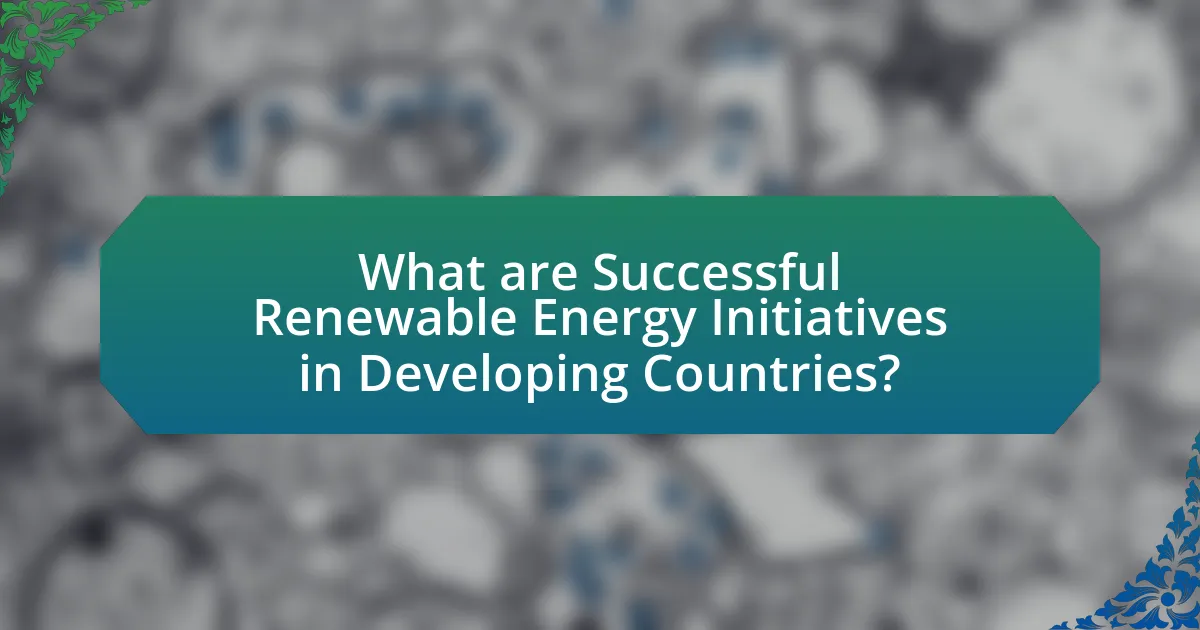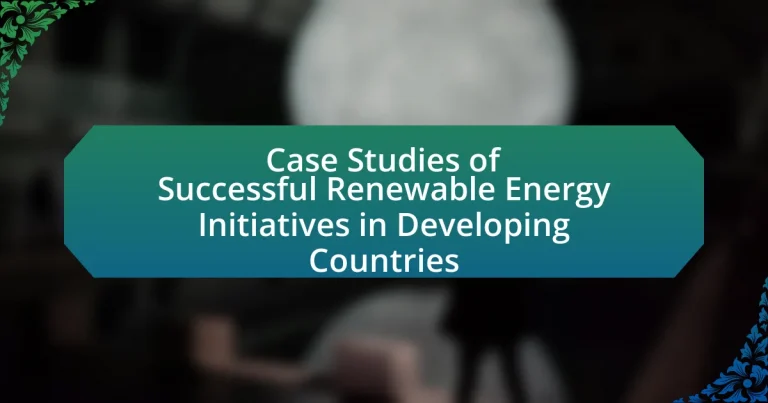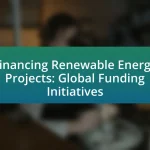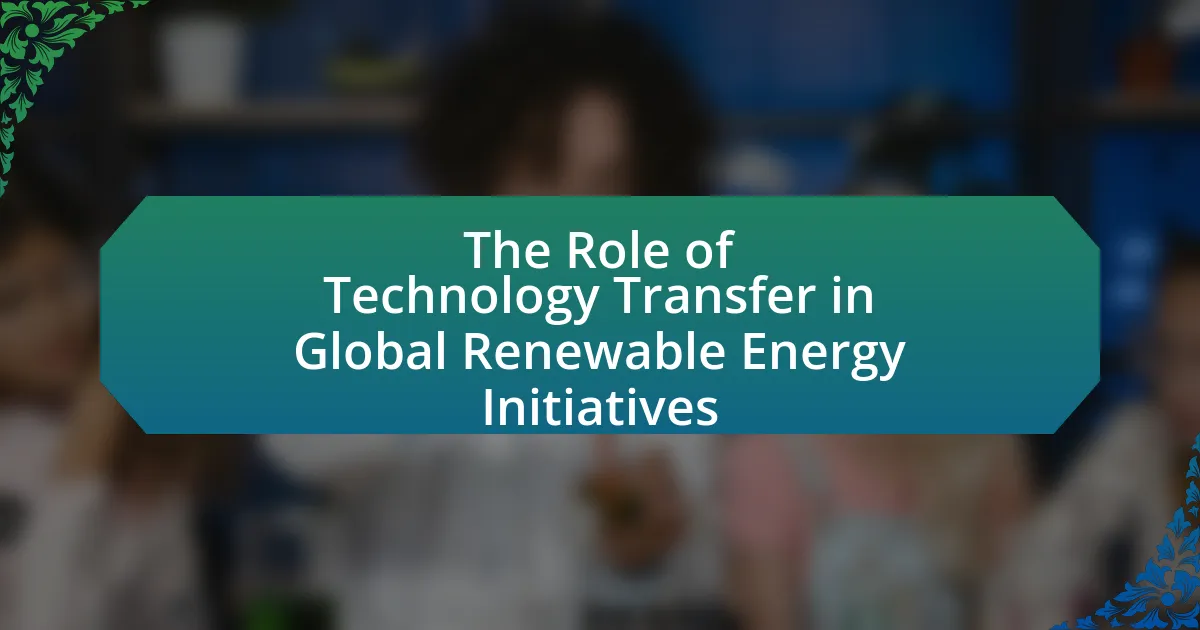The article focuses on successful renewable energy initiatives in developing countries, highlighting key projects such as the Solar Home Systems in Bangladesh, M-KOPA Solar in Kenya, and the Biogas Program in Nepal. These initiatives have significantly improved energy access, enhanced local economies, and provided social benefits, including job creation and better public health outcomes. The article also examines the types of renewable energy utilized, regional variations, and the metrics for measuring success, while discussing the challenges faced and lessons learned from these case studies. Furthermore, it explores future prospects for renewable energy in developing nations, emphasizing the role of technology, partnerships, and best practices in promoting sustainable energy solutions.

What are Successful Renewable Energy Initiatives in Developing Countries?
Successful renewable energy initiatives in developing countries include the Solar Home Systems project in Bangladesh, which has installed over four million solar home systems, providing electricity to approximately 20 million people. This initiative has significantly improved access to energy in rural areas, reducing reliance on kerosene and enhancing quality of life. Another example is the M-KOPA Solar in Kenya, which offers pay-as-you-go solar energy solutions, enabling low-income households to access affordable solar power. This model has connected over one million homes to solar energy, demonstrating a sustainable approach to energy access. Additionally, the Biogas Program in Nepal has successfully installed over 300,000 biogas plants, providing clean cooking fuel and reducing deforestation. These initiatives showcase effective strategies for renewable energy deployment in developing regions, addressing energy poverty and promoting sustainable development.
How do these initiatives impact local communities?
Renewable energy initiatives significantly enhance local communities by providing access to clean energy, which improves living standards and promotes economic development. For instance, in rural areas of Bangladesh, solar home systems have enabled over 4 million households to access electricity, leading to increased educational opportunities and improved health services. Additionally, these initiatives create jobs in installation and maintenance, contributing to local economies. A study by the International Renewable Energy Agency (IRENA) found that renewable energy projects can create up to three times more jobs than fossil fuel projects, further demonstrating their positive impact on community development.
What are the social benefits of renewable energy initiatives?
Renewable energy initiatives provide significant social benefits, including job creation, improved public health, and enhanced energy access. These initiatives often lead to the development of local economies by generating employment opportunities in installation, maintenance, and operation of renewable energy systems. For instance, a report by the International Renewable Energy Agency (IRENA) indicated that the renewable energy sector employed over 11 million people globally in 2018, with a substantial portion of these jobs located in developing countries.
Additionally, renewable energy reduces reliance on fossil fuels, which can lead to improved air quality and public health outcomes. A study published in the journal Environmental Science & Technology found that transitioning to renewable energy sources could prevent millions of premature deaths associated with air pollution. Furthermore, renewable energy initiatives often focus on providing energy access to underserved communities, thereby improving education, healthcare, and economic opportunities. For example, solar microgrid projects in rural areas of India have successfully increased electricity access, enabling schools and clinics to operate more effectively.
Overall, the social benefits of renewable energy initiatives are evident in their capacity to foster economic growth, enhance public health, and improve energy access in developing regions.
How do these initiatives contribute to economic development?
Renewable energy initiatives contribute to economic development by creating jobs, reducing energy costs, and fostering sustainable growth. For instance, the deployment of solar energy projects in countries like Kenya has led to the creation of thousands of jobs in installation and maintenance, significantly boosting local employment rates. Additionally, these initiatives lower energy expenses for households and businesses, which can increase disposable income and stimulate local economies. A report by the International Renewable Energy Agency (IRENA) indicates that the renewable energy sector employed over 11 million people globally in 2018, demonstrating the sector’s potential to drive economic growth in developing regions.
What types of renewable energy are being utilized?
The types of renewable energy being utilized include solar energy, wind energy, hydroelectric power, biomass, and geothermal energy. Solar energy harnesses sunlight through photovoltaic cells or solar thermal systems, while wind energy captures kinetic energy from wind using turbines. Hydroelectric power generates electricity by utilizing flowing water, typically from rivers or dams. Biomass energy is derived from organic materials, such as plant and animal waste, which can be converted into biofuels or used directly for heating. Geothermal energy taps into the Earth’s internal heat for electricity generation and direct heating applications. These renewable energy sources are increasingly adopted in developing countries to enhance energy access and sustainability.
What are the most common renewable energy sources in developing countries?
The most common renewable energy sources in developing countries are solar energy, wind energy, and biomass. Solar energy is widely utilized due to its accessibility and decreasing costs, with countries like India and Kenya leading in solar installations. Wind energy is also gaining traction, particularly in regions with favorable wind conditions, such as South Africa and Morocco, which have invested in large-scale wind farms. Biomass remains significant, especially in rural areas where it is used for cooking and heating, with countries like Ethiopia and Bangladesh relying heavily on biomass for energy needs. These sources are increasingly recognized for their potential to provide sustainable energy solutions and reduce reliance on fossil fuels.
How do these energy sources vary by region?
Energy sources vary significantly by region due to factors such as resource availability, technological development, and policy frameworks. For instance, Sub-Saharan Africa predominantly relies on biomass and hydroelectric power, with countries like Ethiopia harnessing significant hydro resources, while solar energy is increasingly utilized in countries like Kenya. In contrast, Southeast Asia, particularly countries like Indonesia and the Philippines, leverage geothermal energy due to their volcanic activity, alongside growing investments in solar and wind energy. Furthermore, Latin America, especially Brazil, utilizes a mix of hydropower and bioenergy, with sugarcane ethanol being a notable example. These regional variations are influenced by local climate conditions, economic priorities, and government incentives, demonstrating the diverse landscape of renewable energy initiatives across developing countries.
Why are these initiatives considered successful?
These initiatives are considered successful because they effectively increase access to clean energy while promoting economic growth and sustainability in developing countries. For instance, projects like solar microgrids in rural areas have provided electricity to communities that previously relied on expensive and polluting energy sources, resulting in improved quality of life and economic opportunities. Additionally, the World Bank reported that renewable energy initiatives in countries such as Kenya and Bangladesh have led to job creation and enhanced local economies, demonstrating their multifaceted benefits.
What metrics are used to measure success in renewable energy projects?
Success in renewable energy projects is measured using metrics such as energy output, cost-effectiveness, return on investment (ROI), and environmental impact. Energy output quantifies the amount of electricity generated, often expressed in megawatt-hours (MWh), which indicates the project’s efficiency and reliability. Cost-effectiveness evaluates the total costs relative to the energy produced, typically measured in terms of levelized cost of energy (LCOE), which allows for comparison across different technologies. ROI assesses the financial returns generated by the project compared to its initial investment, providing insight into its economic viability. Environmental impact metrics include reductions in greenhouse gas emissions and improvements in air quality, which are critical for evaluating the sustainability of renewable energy initiatives. These metrics collectively provide a comprehensive framework for assessing the success of renewable energy projects, particularly in the context of developing countries where such initiatives can significantly contribute to energy access and environmental sustainability.
How do these initiatives achieve sustainability?
These initiatives achieve sustainability by integrating renewable energy sources, such as solar and wind, into local energy systems, which reduces reliance on fossil fuels. For example, projects in countries like Kenya and India have successfully implemented solar microgrids that provide electricity to rural communities, thereby decreasing carbon emissions and promoting energy independence. Additionally, these initiatives often involve community engagement and capacity building, ensuring that local populations are equipped to maintain and manage the systems, which further enhances long-term sustainability.

What are the Key Case Studies of Renewable Energy Initiatives?
Key case studies of renewable energy initiatives include the Solar Home Systems project in Bangladesh, which has installed over 4 million solar home systems, providing electricity to approximately 20 million people. This initiative has significantly improved energy access in rural areas, reducing reliance on kerosene and enhancing quality of life. Another notable case is the wind energy project in India, particularly the Kutch region, where wind farms have generated over 10,000 MW of electricity, contributing to the country’s renewable energy capacity and creating jobs. Additionally, the biogas program in Nepal has successfully installed thousands of biogas plants, providing clean cooking fuel and reducing deforestation. These case studies demonstrate the effectiveness of renewable energy initiatives in improving energy access and promoting sustainable development in developing countries.
Which countries have notable examples of successful initiatives?
Countries with notable examples of successful renewable energy initiatives include Kenya, India, and Brazil. Kenya has implemented the M-Pesa mobile payment system, facilitating access to solar energy for rural communities, resulting in over 1 million solar home systems installed. India has launched the Solar Mission, aiming for 100 GW of solar power by 2022, which has led to significant investments and job creation in the renewable sector. Brazil’s Proinfa program has successfully integrated wind and biomass energy, contributing to over 10% of its electricity generation from renewable sources. These initiatives demonstrate effective strategies in advancing renewable energy in developing nations.
What specific projects in India demonstrate success in renewable energy?
The specific projects in India that demonstrate success in renewable energy include the Kamuthi Solar Power Project, which has a capacity of 648 MW and is one of the largest solar power plants in the world, and the Rewa Ultra Mega Solar Park, which has a capacity of 750 MW and has set a record low tariff for solar energy. Additionally, the Sardar Patel Renewable Energy Park, with a planned capacity of 30,000 MW, showcases India’s commitment to large-scale renewable energy initiatives. These projects collectively contribute to India’s goal of achieving 175 GW of renewable energy capacity by 2022, reflecting significant advancements in solar energy technology and investment.
How has Kenya’s approach to renewable energy set a benchmark?
Kenya’s approach to renewable energy has set a benchmark through its significant investment in geothermal, wind, and solar energy, making it a leader in Africa. The country generates approximately 90% of its electricity from renewable sources, with geothermal energy alone contributing around 50% of the total electricity supply, as evidenced by the Olkaria Geothermal Plant, one of the largest in Africa. Additionally, Kenya’s ambitious goal to achieve universal access to electricity by 2022 was supported by initiatives like the Last Mile Connectivity Project, which expanded the grid to rural areas. These efforts have not only increased energy access but also attracted international investments, showcasing a successful model for other developing nations to follow.
What lessons can be learned from these case studies?
The lessons learned from case studies of successful renewable energy initiatives in developing countries include the importance of community involvement, the necessity of tailored solutions, and the effectiveness of public-private partnerships. Community involvement ensures that projects meet local needs and gain public support, as evidenced by the Solar Home Systems project in Bangladesh, which engaged local communities in implementation and maintenance. Tailored solutions address specific regional challenges, demonstrated by the use of micro-hydropower in remote areas of Nepal, which provided reliable energy where grid access was impractical. Public-private partnerships, such as those seen in Kenya’s M-KOPA Solar, illustrate how collaboration can leverage resources and expertise to scale renewable energy access effectively. These case studies highlight that successful renewable energy initiatives require a multifaceted approach that considers local contexts and stakeholder engagement.
What challenges did these initiatives face and how were they overcome?
The renewable energy initiatives in developing countries faced challenges such as inadequate infrastructure, limited funding, and lack of technical expertise. These challenges were overcome through partnerships with international organizations, which provided financial support and technical training. For instance, the Solar Home Systems project in Bangladesh successfully addressed funding issues by leveraging microfinance models, allowing households to afford solar installations. Additionally, capacity-building programs were implemented to enhance local skills, ensuring sustainability and effective maintenance of the renewable energy systems.
How can these lessons be applied to future projects?
The lessons from successful renewable energy initiatives in developing countries can be applied to future projects by implementing community engagement strategies, ensuring financial sustainability, and adapting technologies to local contexts. Community engagement fosters local ownership and support, as seen in the Solar Sister initiative, which empowers women to distribute solar products, leading to increased adoption rates. Financial sustainability can be achieved through innovative funding models, such as pay-as-you-go systems, which have proven effective in projects like M-KOPA in Kenya, allowing users to pay for solar energy in manageable installments. Additionally, adapting technologies to fit local needs and resources, as demonstrated by the use of locally sourced materials in biogas projects in India, enhances project viability and acceptance. These approaches provide a framework for replicating success in future renewable energy projects.

What are the Future Prospects for Renewable Energy in Developing Countries?
The future prospects for renewable energy in developing countries are highly promising, driven by increasing investments, technological advancements, and supportive policies. According to the International Renewable Energy Agency (IRENA), renewable energy capacity in developing nations is expected to grow significantly, with projections indicating that by 2030, these countries could account for over 60% of global renewable energy capacity additions. This growth is supported by the declining costs of solar and wind technologies, which have seen price reductions of over 80% in the last decade, making them more accessible. Additionally, initiatives such as the United Nations’ Sustainable Development Goals emphasize the importance of clean energy access, further encouraging investments in renewable projects.
How can technology enhance renewable energy initiatives?
Technology can enhance renewable energy initiatives by improving efficiency, reducing costs, and enabling better integration of renewable sources into existing energy systems. For instance, advancements in solar panel technology, such as bifacial panels, have increased energy capture by up to 27% compared to traditional panels, making solar energy more viable in developing countries. Additionally, smart grid technology allows for real-time monitoring and management of energy distribution, which optimizes the use of renewable resources and reduces waste. According to the International Renewable Energy Agency, the global cost of solar energy has dropped by 89% since 2009, demonstrating how technology can drive down expenses and make renewable energy more accessible.
What role does innovation play in scaling renewable energy solutions?
Innovation is crucial for scaling renewable energy solutions as it drives technological advancements, reduces costs, and enhances efficiency. For instance, innovations in solar panel technology, such as bifacial panels and perovskite materials, have significantly increased energy output while decreasing production costs. According to the International Renewable Energy Agency (IRENA), the cost of solar photovoltaic systems has dropped by 82% since 2010, largely due to innovative manufacturing processes and materials. Furthermore, innovations in energy storage, like lithium-ion batteries, enable better integration of renewable sources into the grid, addressing intermittency issues. These advancements not only make renewable energy more accessible but also facilitate the deployment of large-scale projects in developing countries, thereby accelerating the transition to sustainable energy systems.
How can partnerships between governments and NGOs improve outcomes?
Partnerships between governments and NGOs can improve outcomes by leveraging resources, expertise, and networks to implement effective renewable energy initiatives. For instance, governments provide regulatory frameworks and funding, while NGOs contribute grassroots knowledge and community engagement strategies. A study by the World Resources Institute highlights that collaborative efforts in renewable energy projects, such as the Solar Sister initiative in Africa, have led to increased access to clean energy for over 1 million people, demonstrating the tangible benefits of such partnerships.
What are the best practices for implementing renewable energy projects?
The best practices for implementing renewable energy projects include thorough feasibility studies, stakeholder engagement, and securing financing. Conducting comprehensive feasibility studies ensures that the project is viable in terms of technical, economic, and environmental aspects. Engaging stakeholders, including local communities and government entities, fosters support and addresses potential concerns, which is crucial for project acceptance and success. Securing financing through diverse sources, such as grants, loans, and public-private partnerships, is essential to cover initial costs and sustain long-term operations. These practices are supported by successful case studies, such as the Solar Home Systems project in Bangladesh, which has provided electricity to millions and demonstrates the importance of community involvement and financial planning in renewable energy initiatives.
What strategies ensure community involvement and support?
Effective strategies for ensuring community involvement and support in renewable energy initiatives include participatory planning, education and awareness programs, and stakeholder engagement. Participatory planning allows community members to contribute to decision-making processes, fostering a sense of ownership and commitment. Education and awareness programs inform the community about the benefits of renewable energy, enhancing public support and participation. Stakeholder engagement involves collaborating with local leaders and organizations to build trust and address community concerns, which has been shown to increase project acceptance and sustainability. For instance, a study by the International Renewable Energy Agency (IRENA) highlights that projects with strong community engagement have a 30% higher success rate in implementation compared to those without.
How can funding and investment be secured for future initiatives?
Funding and investment for future initiatives can be secured through a combination of public-private partnerships, grant applications, and innovative financing mechanisms. Public-private partnerships leverage resources and expertise from both sectors, enhancing project viability and attracting investors. For instance, the Solar Energy Corporation of India successfully partnered with private firms to expand solar capacity, demonstrating the effectiveness of this approach. Additionally, applying for grants from international organizations, such as the Green Climate Fund, provides essential financial support for renewable energy projects in developing countries. Innovative financing mechanisms, like green bonds, have also emerged as effective tools, with the Climate Bonds Initiative reporting that green bond issuance reached $269.5 billion in 2020, showcasing the growing interest in sustainable investments.
What practical steps can be taken to promote renewable energy initiatives?
To promote renewable energy initiatives, governments and organizations can implement policies that incentivize investment in renewable technologies, such as tax credits and subsidies. For example, the International Renewable Energy Agency reported that countries offering financial incentives have seen a significant increase in renewable energy capacity; Germany’s feed-in tariff policy led to a tenfold increase in solar energy installations from 2000 to 2010. Additionally, establishing public-private partnerships can facilitate funding and resource sharing, as demonstrated by the Solar Home Systems project in Bangladesh, which provided solar power to over four million households. Education and awareness campaigns can also drive community engagement and support for renewable projects, as seen in Kenya, where local training programs have empowered communities to adopt solar energy solutions.




